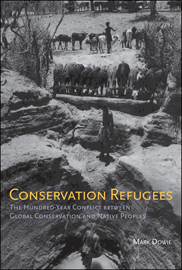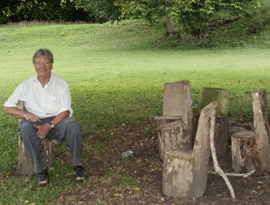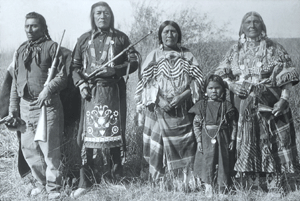Conservation Refugees
Air Date: Week of July 24, 2009

Indigenous peoples are sometimes kicked off of their land to make way for national parks and reserves for charismatic wildlife. They essentially become refugees in the name of conservation, says author and environmental journalist Mark Dowie. Dowie talks with Steve Curwood about his new book, Conservation Refugees: The Hundred-Year Conflict between Global Conservation and Native Peoples.
Transcript
YOUNG: It’s Living on Earth, I’m Jeff Young.
For the past 100 years, the conservation movement has aimed to protect the natural world. But there’s sometimes a dark side to conservation that’s ignored – indigenous people can lose out.
Investigative journalist Mark Dowie aims to set the record straight in his new book Conservation Refugees: The Hundred-Year Conflict Between Global Conservation and Native Peoples.

Author Mark Dowie. (Photo: Peter Poole)
DOWIE: This is an institution called conservation that is trying to do the right thing for the planet and for all of us really. I mean protecting biological diversity is essential to the future of human life, so they are good guys. They’ve just been doing it the wrong way for a hundred years. And I think now they would agree with me.
CURWOOD: So if you look at the origins of the conservation movement as you do in your book Conservation Refugees, you see that hey, this is something homegrown here in America. It comes about really with the creation of Yosemite. What happened there?
DOWIE: Yosemite National Park was formed very gradually, actually largely in a response to wilderness romantics like John Muir who in the course of arguing that Yosemite should be turned into a park basically overlooked the fact that people had been living there for 4,000 years. That fact of the matter is people, the Miwoks mainly and a couple of other tribes had been living in that area quite successfully for 4,000 years. It looked like wilderness because they weren’t fencing it and culturing it the way modern agriculture does, but they were living there and they were growing things and planting things and setting fires to keep the brush down and keep the soil rich.
But Muir decided that this was a wonderful place to rest your soul and a place for weary urbanites to leave the city for a while and think about wilderness. And of course it was. But he didn’t think they would be able to accomplish that in the company of Natives. So he arranged and argued that the Natives should be removed. He really didn’t have a lot of use for Native Americans. Although he worked with them for a while.
CURWOOD: So this was part of America’s ethnic cleansing you call it in your book.
DOWIE: Yeah, it went on from Yosemite to seven other national parks all of which were occupied by Native people. Yellowstone principally was actually occupied by seven different tribes. And the government had quite a job getting them out of Yellowstone. In fact, there was one day when the Shoshone refused to leave and the government killed 300 of them in one day to clear the park or national protected area.

A historic photo of members of the Bannock, part of the Shoshonean tribe. (Courtesy of Yellowstone National Park)
DOWIE: Yes. Teddy Roosevelt said “The rude, fierce settler who drives the savage from the land lays all civilized mankind under a debt to him. It is of incalculable importance that America, Australia and Siberia should pass out of the hands of the red, black and yellow aboriginal owners and become the heritage of the dominant world races.”
CURWOOD: So that attitude in – what – 1904.
DOWIE: Uh-huh.
CURWOOD: … that conservation was for white Europeans and that red, black and yellow aboriginal folks were really not qualified to be stewards of their own land – sets well frankly a racist tone to the conservation movement I would say.
DOWIE: Well it does. You know when the Sierra Club supported the opening of parks around the country; a lot of the parks were posted whites only. And the Sierra Club voted to support that policy ‘til about 1920. So, yeah, I mean racism is much more shocking now than of course it was then. And you know I don’t use the word once in my book, because you really don’t have to. The story of racism tells itself in the book. And it’s quotes like that from Teddy Roosevelt that help me out in not having to use the word.
CURWOOD: So America exports its brand of conservation including ethnic attitudes. There’s an example involving the Maasai.
DOWIE: Well the Maasai, the ancient nomadic pastoral tribe that had been wandering up and down the Rift Valley for thousands of years were gradually denied their best basically watering holes and grazing places because they also happened to be watering holes and grazing places for charismatic wildlife which was a tourist draw for the countries involved, mainly Kenya and Tanzania. And it’s that denial of range and graze to a pastoral culture ultimately destroys the culture.
So you have Massai men now working as security guards in Dar es Salaam and bodyguards for brothels and that sort of life which is just not the life that they ever saw for themselves. But their cattle has been confiscated and they’ve been basically pushed off their land in the end in the interests of – punitive interests of conservation and also the interest of tourism.
CURWOOD: So the American conservation movement has been quite open about asserting that humans and wilderness are inherently incompatible. I think of the Wilderness Act that defines wilderness areas in America as being untrammeled by man, man is just a visitor. But of course one of the most important themes in your book, Mark Dowie, is that indigenous people can often do an amazing job managing the land.
DOWIE: Well that’s the irony of it, and I think its an irony that the BINGOs, the Big, International NGOs that are really controlling the conservation agenda, they’re beginning to realize that very fact that the best stewards of the land are the people who’ve been living there for a long time. There’s a lot of scientific proof of this now, a lot of correlation, map correlation, of high biodiversity and stable populations around the world.
Even in part of the developed world, people who have studied Maasai pastoral practices and traditional ecological knowledge are amazed at how well they managed their land when they had it. They knew exactly when to move their cattle out of certain areas because there were disease and disease vectors that would come in at certain times of the year. They knew to move their cattle to other graze at that time. Knew exactly when water was going to dry up and when they had to find another source of water. I mean the Rift Valley is a very challenging place to run cattle.
CURWOOD: I had the experience of going to Grand Canyon National Park here in the United States and just as I got there, maybe not too much longer afterwards, very conveniently the Hopi put on quite a dance – I think it was a rain dance or something. You write in your book that indigenous people sometimes wind up in a human zoo. How well are the indigenous folks doing in this land of ecotourism?
DOWIE: Yes. I mean some of the communities that are formed of people who have been evicted from their land and then they’re hired as tour guides and managers of the protected area, sometimes as eco-guards protecting the wildlife. And some of them make a little extra money by coming over and performing at the ecologies. And what was interesting to me – I happened to pass through an eco-lodge in Kenya while I was there. And some Massai came in and did a dance in the evening and the next day I took a walking safari with the Massai leader and I told him I’d seen this. And he said, “Well none of those guys were Maasai. Maasai won’t do that.”
[LAUGHING]
DOWIE: “… they were just tall guys that they hired in town and taught how to jump up and down to music.” I mean most indigenous people you know are aware of the fact they’re being put on show and they resent it as part of the eco-tourist package.
CURWOOD: So in terms of future international conservation efforts, what do you see as the appropriate models going forward?
DOWIE: Basically what I mentioned: models where indigenous people are involved in the conservation of the area and are allowed to stay inside the conservation area. Now if it’s gonna remain a conservation area, there may have to be a slightly altered social contract involving, for example, hunting of bush meat and what bush meat can be hunted for. No more commercial hunting of bush meat. No more commercial logging of trees. If it is going to be a protected area, it should be protected.
Most of the indigenous leaders that I interviewed around the world told me that they would be willing to return to their land, their original land, under a new contract with conservation. And involving them in the protection of biological diversity, to me is absolutely essential. And I think that’s the emerging paradigm for conservation in the world. And a lot of Conservations are beginning to agree with me.

DOWIE: Well that’s the subtext of this whole story, Steve, is the conflict between two very august sciences really: anthropology and wildlife biology, both of whom see wildlife and wilderness and land in very, very different lights. And it’s only been recently when they’ve begun to meet and talk about the interconnection between cultural diversity and biological diversity and how inseparable they are and how without one you’re not going to get the other. And I think that’s been largely the argument of the anthropologists that cultural diversity can only thrive side by side with biological diversity and vice versa.
CURWOOD: Language plays an important part of your book. And I’m struck by your comment that many indigenous groups haven no word for wilderness.
DOWIE: Yes, it’s true. I use the word a lot in interviews, and of course it translates badly into those languages. And people would be baffled – what’s he talking about, what is that word, that word’s not in our language. One Ojibway woman I was interviewing in North Canada, when her daughter who has doing the translation finally was able to through to her roughly what I was saying she started to laugh. And I said, “what’s so funny?” And her daughter said, “well the only place in the world where she’s ever seen what you’re calling wildness is in a street corner in front of the bus station in Winnipeg Manitoba.
[LAUGHING]
DOWIE: So it’s a hard concept. It’s a concept that we’re lived with for generations in the west because we value wilderness and we’ve been trying to protect wilderness and we’ve passed laws and we have huge organizations that are protecting wilderness. And most of us love it when we find and enter wilderness. But it’s not a concept that resonates with indigenous people who live in what we call wilderness but they also live off it.
CURWOOD: Mark, I’m wondering if we’re kidding ourselves to think that as humans we could be separate from what we label wilderness.
DOWIE: That’s exactly the point of the book really. We can’t. We’re part of it. We come from it. Our genes and our DNA are all derived from wilderness. And why avoid it? Why separate humans from nature? Why separate humans from wilderness?
YOUNG: Author Mark Dowie in conversation with Steve Curwood. Dowie’s book is Conservation Refugees: The Hundred-Year Conflict Between Global Conservation and Native Peoples.
[MUSIC: Jeff Stott “Saya Nova” from Six Degrees India (Six Degrees Records 2009)]
Living on Earth wants to hear from you!
Living on Earth
62 Calef Highway, Suite 212
Lee, NH 03861
Telephone: 617-287-4121
E-mail: comments@loe.org
Newsletter [Click here]
Donate to Living on Earth!
Living on Earth is an independent media program and relies entirely on contributions from listeners and institutions supporting public service. Please donate now to preserve an independent environmental voice.
NewsletterLiving on Earth offers a weekly delivery of the show's rundown to your mailbox. Sign up for our newsletter today!
 Sailors For The Sea: Be the change you want to sea.
Sailors For The Sea: Be the change you want to sea.
 The Grantham Foundation for the Protection of the Environment: Committed to protecting and improving the health of the global environment.
The Grantham Foundation for the Protection of the Environment: Committed to protecting and improving the health of the global environment.
 Contribute to Living on Earth and receive, as our gift to you, an archival print of one of Mark Seth Lender's extraordinary wildlife photographs. Follow the link to see Mark's current collection of photographs.
Contribute to Living on Earth and receive, as our gift to you, an archival print of one of Mark Seth Lender's extraordinary wildlife photographs. Follow the link to see Mark's current collection of photographs.
 Buy a signed copy of Mark Seth Lender's book Smeagull the Seagull & support Living on Earth
Buy a signed copy of Mark Seth Lender's book Smeagull the Seagull & support Living on Earth

